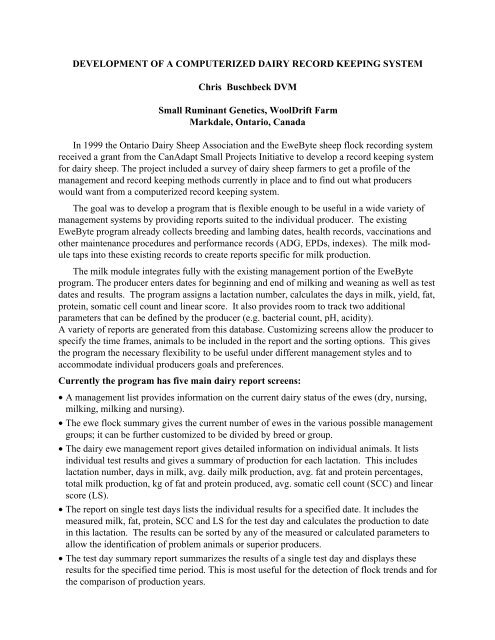Computerized dairy record keeping system.pdf
Computerized dairy record keeping system.pdf
Computerized dairy record keeping system.pdf
Create successful ePaper yourself
Turn your PDF publications into a flip-book with our unique Google optimized e-Paper software.
DEVELOPMENT OF A COMPUTERIZED DAIRY RECORD KEEPING SYSTEM<br />
Chris Buschbeck DVM<br />
Small Ruminant Genetics, WoolDrift Farm<br />
Markdale, Ontario, Canada<br />
In 1999 the Ontario Dairy Sheep Association and the EweByte sheep flock <strong>record</strong>ing <strong>system</strong><br />
received a grant from the CanAdapt Small Projects Initiative to develop a <strong>record</strong> <strong>keeping</strong> <strong>system</strong><br />
for <strong>dairy</strong> sheep. The project included a survey of <strong>dairy</strong> sheep farmers to get a profile of the<br />
management and <strong>record</strong> <strong>keeping</strong> methods currently in place and to find out what producers<br />
would want from a computerized <strong>record</strong> <strong>keeping</strong> <strong>system</strong>.<br />
The goal was to develop a program that is flexible enough to be useful in a wide variety of<br />
management <strong>system</strong>s by providing reports suited to the individual producer. The existing<br />
EweByte program already collects breeding and lambing dates, health <strong>record</strong>s, vaccinations and<br />
other maintenance procedures and performance <strong>record</strong>s (ADG, EPDs, indexes). The milk module<br />
taps into these existing <strong>record</strong>s to create reports specific for milk production.<br />
The milk module integrates fully with the existing management portion of the EweByte<br />
program. The producer enters dates for beginning and end of milking and weaning as well as test<br />
dates and results. The program assigns a lactation number, calculates the days in milk, yield, fat,<br />
protein, somatic cell count and linear score. It also provides room to track two additional<br />
parameters that can be defined by the producer (e.g. bacterial count, pH, acidity).<br />
A variety of reports are generated from this database. Customizing screens allow the producer to<br />
specify the time frames, animals to be included in the report and the sorting options. This gives<br />
the program the necessary flexibility to be useful under different management styles and to<br />
accommodate individual producers goals and preferences.<br />
Currently the program has five main <strong>dairy</strong> report screens:<br />
• A management list provides information on the current <strong>dairy</strong> status of the ewes (dry, nursing,<br />
milking, milking and nursing).<br />
• The ewe flock summary gives the current number of ewes in the various possible management<br />
groups; it can be further customized to be divided by breed or group.<br />
• The <strong>dairy</strong> ewe management report gives detailed information on individual animals. It lists<br />
individual test results and gives a summary of production for each lactation. This includes<br />
lactation number, days in milk, avg. daily milk production, avg. fat and protein percentages,<br />
total milk production, kg of fat and protein produced, avg. somatic cell count (SCC) and linear<br />
score (LS).<br />
• The report on single test days lists the individual results for a specified date. It includes the<br />
measured milk, fat, protein, SCC and LS for the test day and calculates the production to date<br />
in this lactation. The results can be sorted by any of the measured or calculated parameters to<br />
allow the identification of problem animals or superior producers.<br />
• The test day summary report summarizes the results of a single test day and displays these<br />
results for the specified time period. This is most useful for the detection of flock trends and for<br />
the comparison of production years.
A summary report for individual animals is still under construction, but will be added in the<br />
near future. This report will allow comparisons between lactations and years for specified groups<br />
of animals or the entire flock.<br />
The program is currently tested by a number of participating <strong>dairy</strong> producers and will be<br />
released with the next version of EweByte.
















